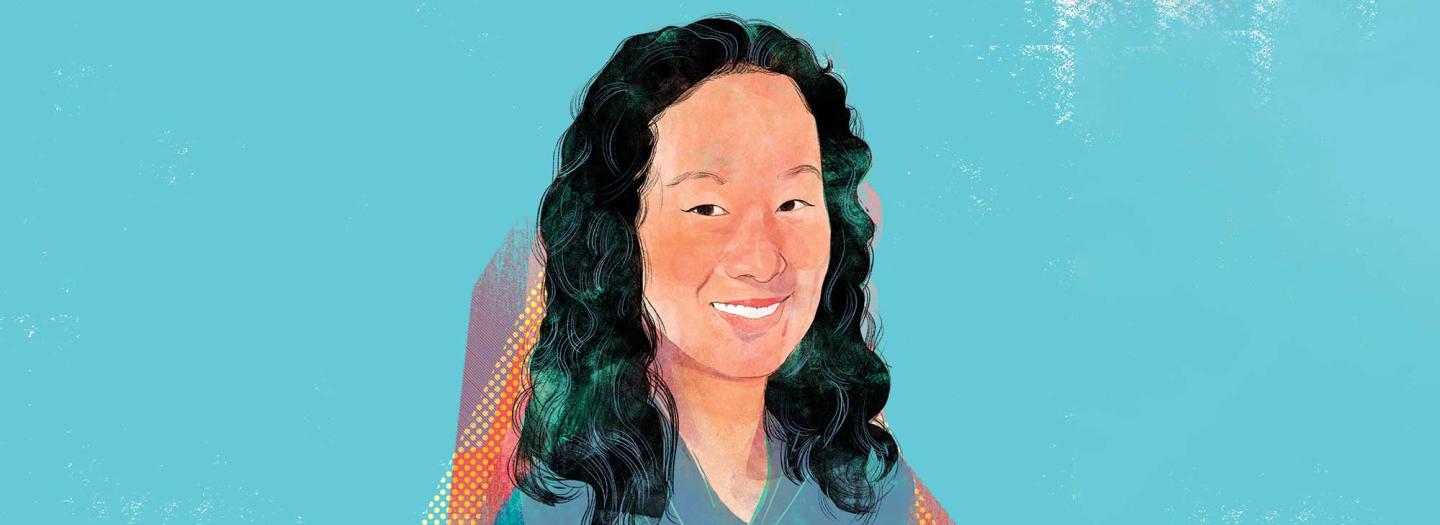Joyce Tung, PhD ’05 : Date with DNA destiny
How a bulletin board flyer launched geneticist Joyce Tung on an unforgettable ride with 23andMe.

The Chinese word for cilantro translates as “fragrant vegetable.” But not if you ask Joyce Tung. She calls it “stinky vegetable.” That’s because Tung, vice president of research at the human genomics and biotech giant 23andMe, has a genetic predisposition to dislike the herb.
It’s the sort of detail you might know if you’re a geneticist – especially one who helps decide which traits are studied in 23andMe’s research program. Tung’s Bay Area-based employer is the only company authorized by the U.S. Food and Drug Administration to deliver genetic test results directly to consumers; like her, more than 13 million other people have submitted their saliva for its inspection.
While the results serve up quirky facts like cilantro aversion, fear of heights, or appeal to mosquitoes (Tung is among those likely to get larger welts from their bites), 23andMe also delivers insights that could have serious implications, such as one’s likelihood of developing type 2 diabetes, Parkinson’s disease, or late-onset Alzheimer’s.
“Empowerment is an important part of 23andMe’s ethos,” says Tung. “We want to empower consumers with information that will enable them to make better decisions. My aspiration is to help people feel confident that they can understand complicated scientific and medical information and feel like peers in health care decision-making with clinicians.”
She happened on the fledgling startup in 2006, while doing a postdoc at Stanford. After spotting a help-wanted ad pinned to a bulletin board, she replied, and in 2007, became one of the company’s first hires. Today, 23andMe is publicly traded and employs more than 700 people.
“The flyer highlighted 23andMe’s desire to use genetics to educate people about their lives,” says Tung. “I was nervous about leaving a very safe postdoc to go to a company with no website or products. I’m not a big risk-taker, but I also thought, ‘This is exactly what I’m interested in doing!’”
Today, she runs the company’s human genetics research program, a role that has her supervising as many as 70 scientists. She oversees data collection and guides the work of statistical and population geneticists, bioinformaticists, epidemiologists, ethicists, and program managers who work with academic and industry partners. Her team also runs an academic collaboration program that has led to most of 23andMe’s more than 200 scientific publications.
Tung recognizes the need for greater racial equity in genetic testing. She worries about the lack of diversity among research subjects both at 23andMe and in general. People of European descent are typically overrepresented in studies. As a result, application of the discoveries may inadvertently be tailored more to that group’s characteristics. “How do we diversify research participants to ensure benefits are equitably distributed? It’s not enough to have the right intentions. Are you actually doing research the right way?” asks Tung, who says 23andMe is studying ways to address the problem.
Privacy concerns over how the company uses customer data have arisen, but Tung says, “One of our core values is that behind every data point is a human being. Our principles are about transparency and choice. At the end of the day, our customers choose how their data is used.”
In 2015, 23andMe formed a therapeutics group to conduct drug discovery and development based on human genetic information, something Tung thinks deserves more awareness. For example, the company launched its first wholly owned phase I clinical trial for an investigational cancer therapy in January 2022. The company also has a collaboration underway with GSK that includes a phase I clinical trial and over 50 preclinical programs. And 23andMe entered into an agreement with Almirall, out-licensing an antibody designed to thwart inflammatory diseases, including various dermatological conditions.
“Instead of using data from mice, flies, or rabbits, we think it’s more efficient to use noninvasive data from humans, and we think we’re going to be two or three times more likely to come up with successful drugs that way,” Tung says.
Tung believes “the sky’s the limit” for human genetic testing. “In 20, 30, or 50 years, we’ll all be sequenced at birth. The goal will be to use that information to help people live the healthiest possible lives,” she predicts.
“I feel lucky to have stumbled upon a company that I just think is super-cool,” Tung says. “It’s been quite a ride.”
– George Spencer for UCSF Magazine
Read the Winter 2023 Issue